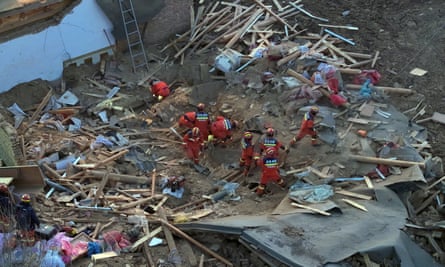Officials said more than 400 people were also injured after the 6.2 magnitude quake in north-west Gansu and Qinghai provinces

At least 118 people have been killed and more than 500 injured in an earthquake in China’s north-west Gansu and Qinghai provinces, state media has reported.
The strong shallow earthquake struck shortly before midnight on Monday, sending residents fleeing outside, into below freezing temperatures. Thousands of houses have been reported damaged, and state media also said public infrastructure had been damaged “to varying degrees”.
The death toll rose on Tuesday morning as rescuers reached affected areas. Gansu authorities said 105 had died in the province, and 397 people had been injured. Qinghai reported 13 dead, 182 injured, and 20 still missing.
It is the deadliest earthquake in China since the 2010 Yushu quake, which also hit Gansu and Qinghai, which measured 6.9 and killed at least 2,698 people.
China’s leader, Xi Jinping, called for “all-out efforts” in the search and rescue work. More than 3,000 firefighters have been deployed or placed on standby, and hundreds of military personnel have been sent to the area. The ministries of finance and emergency management have allocated 200 million RMB (£ 22.1m) in emergency relief funds, according to state media.
Tents, folding beds and quilts were being sent to the disaster area, state broadcaster CCTV said. At least 4,000 firefighters, soldiers and police officers were dispatched in the rescue effort, and the People’s Liberation Army Western Theatre set up a command post to direct its work.

Han, the Gansu spokesperson, said rescue work was proceeding in an orderly manner and asked people to avoid going to the quake-hit areas to prevent traffic jams that could hinder the effort.
A video posted by the ministry of emergency management showed emergency workers in orange uniforms using rods to try to move heavy pieces of what looked like concrete debris at night. Other nighttime videos distributed by state media showed workers lifting out a victim and helping a slightly stumbling person to walk in an area covered with light snow.
Footage from the scene showed rescuers working by torchlight, helping people out of collapsed houses.
Photos and videos posted by a student at Lanzhou University showed students hastily leaving a dormitory building and standing outside with long down jackets over their pajamas.
“The earthquake was too intense,” said Wang Xi, the student who posted the images. “My legs went weak, especially when we ran downstairs from the dormitory.”

“Human beings are really insignificant in the face of natural disasters,” said one Gansu resident on Weibo. “I was at the epicentre of the earthquake, and my mother and I couldn’t run away. The house was shaking so much that I couldn’t even stand up, and things were falling down. It was very cold outside at more than ten degrees below zero. I didn’t go back all night and there were constant aftershocks.”
The resident later said they had returned to their house but the situation in neighbouring villages, where the houses were very old, were “very serious”.
Chinese authorities measured the quake at a magnitude of 6.2. The US geological survey (USGS) reported earlier that it was 5.9.
The earthquake struck at a depth of 10km, about 100km south-west of Gansu province’s capital, Lanzhou. Much of China is in the midst of a cold wave which swept through last week, and the high-altitude area where the earthquake hit reported temperatures of -14C on Tuesday morning.https://interactive.guim.co.uk/uploader/embed/2023/12/embed-2023-12-19t131202-529-zip/giv-13425FGbFbcsetAwUMap of the two provinces in China hit by the earthquake.
Aftershock continued on Tuesday, with several tremors measuring between 3.0 and 4.5. On Tuesday a separate 5.5 magnitude earthquake struck Xinjiang province, also in the northwest.
Earthquakes are somewhat common in the mountainous area of western Chinam, which rises up to form the eastern edge of the Tibetan plateau.
In August, a shallow 5.4-magnitude earthquake struck eastern China, injuring 23 people and collapsing dozens of buildings.
China’s deadliest earthquake in recent years was a 7.9 magnitude quake in 2008 that killed nearly 90,000 people in Sichuan.
The temblor devastated towns, schools and rural communities outside Chengdu, leading to a years-long effort to rebuild with more resistant materials.

